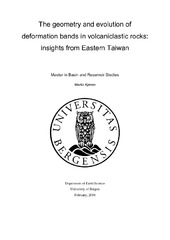The geometry and evolution of deformation bands in volcaniclastic rocks: insights from Eastern Taiwan
Master thesis
Permanent lenke
https://hdl.handle.net/1956/17636Utgivelsesdato
2018-04-17Metadata
Vis full innførselSamlinger
- Department of Earth Science [1048]
Sammendrag
Deformation bands are millimeter to centimeter tabular zones formed by strain localization in porous, granular media, most commonly found in porous sandstones. They also occur in carbonates and volcaniclastics, but are less understood in these rocks. This MSc thesis characterizes deformation bands in volcaniclastic rocks through field-based studies carried out in deformed tuffs in Shihtiping, Eastern Taiwan, in an attempt to document their geometry, evolution and deformation mechanisms. The studied bands are hosted in a 38-meter-thick succession of pyroclastic and volcaniclastic deposits that formed related to the Luzon volcanic arc activity in Miocene times. Subsequently, the bands developed in response to shortening due to plate convergence between the Eurasian Plate and Philippine Sea Plate. Three types of deformation bands are documented in the studied Shihtiping succession. The classification is based upon the orientation of the bands relative to bedding, kinematic vector, and the porosity decrease relative to the host rock, and are termed: i) Pure compaction bands which express loss of volume/porosity without shear displacement, ii) Reverse compactional shear bands and, iii) Strike-slip compactional shear bands that show cataclastic deformation mechanisms and slip surfaces. Findings in this study suggests that interplay between granular flow and cataclastic mechanisms dominate development of the studied deformation bands. Notably, both mechanisms are heavily influenced the orientation of mineral cleavage relative to the deformation band. Microstructural investigations have, for the first time, documented the occurrence of S-C fabric in deformation bands within volcaniclastic host rocks. Further findings within this thesis shed light on the on the geometry and evolution of deformation bands in porous, non-welded tuffs. Field-observations and microstructural evidence suggests that pure compaction bands were the first to develop, followed by reverse compactional shear bands and strike-slip compactional shear bands, respectively. In addition to improving the understanding of deformation bands in volcaniclastic rocks, this outcrop-based study provides analogs for volcaniclastic subsurface reservoirs. This can further lead to an advance in the understanding of reservoirs, concerning, e.g. geothermal energy, hydrocarbons, groundwater contamination, and ore deposition.
